Jennifer Findley 4th Grade Reading Pacing Guide
Allow'due south be real for a moment. During my outset year teaching I did a terrible, horrible, rotten chore at teaching writing. My students (3rd graders at the time) were not assessed on writing, and I really didn't know how to teach writing at that point in my career (especially since my students seriously struggled with all things literacy when they came to me).
I recollect pedagogy information technology and having some fun lessons that I am sure helped the students a little. But mostly, nosotros just aimlessly read read alouds, wrote to prompts, and shared our writing. I "did" all the right things but I didn't do them very purposefully or effectively. I honestly feel like I should write a formal amends to my first grouping of students.
Fast forward a few years and a course level alter, and I finally feel like I have a handle on educational activity writing. I am super purposeful and everything I practice now has a reason backside it. Though my instruction is still not perfect (is anything in teaching ever perfect?), I feel much more than confident that I am growing my students as writers and helping them to dear writing.
In this postal service, I desire to share how I teach writing in 5th grade (very applicable to 3rd and 4th grade as well).
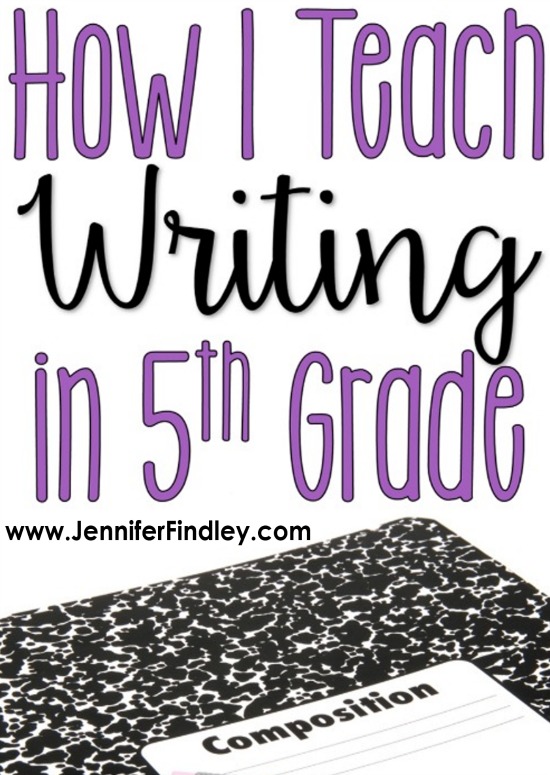
Pacing
I spend approximately 9 weeks on each main genre of writing (narrative, persuasive, and informational/expository). I teach the writing genres in this club: personal narrative, fictional narrative, persuasive, how-to informational, compare and contrast, descriptive/explanatory informational.
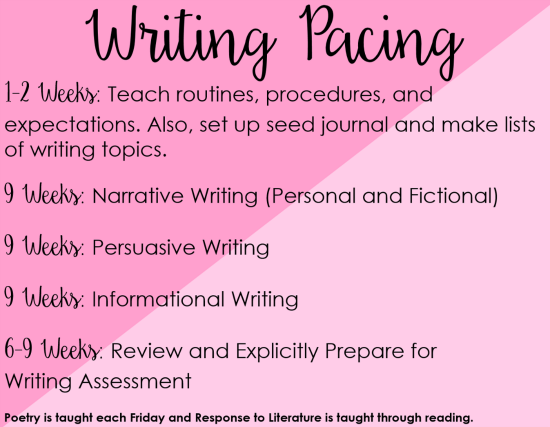
Closer Look at Each 9 Weeks
Now, lets have a closer expect at what each of those ix weeks would look similar:
Ii Weeks Explicitly Teaching Genre
I spend the first two weeks of my pacing explicitly teaching the aspects of the genre we are studying and writer's arts and crafts as it relates to the genre nosotros are studying. We do this by reading mentor texts and making charts nearly what we notice the author does well. These noticings then turn into mini-lessons. You can read more about how I come up with writing mini-lessons (and the three types of mini-lessons) past clicking here.
During these two weeks, the students are writing their starting time essays in this genre, merely it is very guided. For example, we would read mentor texts to look for skillful ancestry, and then we create a chart of skilful beginnings, and so we choose a writing topic from our lists (read more than most that here), and practice writing adept beginnings. I may have the students write ii-3 beginnings, and then chose their favorite. Nosotros likewise spend a lot of time sharing during this fourth dimension so the students tin employ what they are learning and hear lots of examples from their peers.
Three Due westeeks of Writing Based on Lists and Specific Lessons Based on Students' Writing
Afterwards we accept learned and applied all the strategies for a genre to one piece of writing, we are set to endeavor out some more. In this three calendar week period, the students choose more topics from their lists to write about.
As the students are writing, they are referring to charts and examples from our previous mini-lessons to help them utilize what they have learned. I also practise a lot of conferences during this time, but mostly lean-in conferences because I desire the students writing and trying out the new strategies.
The mini-lessons during this fourth dimension frame are very specific to the students' writing. While I am completing my lean-conferences, I jot down notes of struggles and strengths. At this bespeak in the education, I am writing notes well-nigh conventions and mechanics for future mini-lessons, but my main focus is on the writer's craft and getting the students to write and effort out the genre.
At this point, it is also clear which students need all-encompassing re-teaching. About 2-3 times a week, I pull small groups for re-instruction. Notwithstanding, I typically just pull the students who are seriously struggling at this point in instruction.
Iii Weeks of Writing to On-Demand Prompts
At this betoken in our pacing, I take taught a lot of writing craft skills, and the students have several essays, applying what they have learned (usually 3-five essays by this betoken). Now, it is time to get into perfecting their conventions and practicing on need prompts.
The lessons during this three week period are very mini and focus more often than not on conventions and mechanics. These lessons come from what I see as a demand during my lean-in conferences and what I know volition help move my students across their current writing (varying judgement lengths, using circuitous sentences, using introductory phrases, etc).
As well during this time, we typically have a longer share fourth dimension, and so the students can hear each other's writing, requite and get feedback, and learn even more writing strategies to use in their own writing.
As I mentioned higher up, this fourth dimension is also spent primarily writing to on-demand prompts. These tin can be a elementary prompt, a prompt that besides uses a text stimulus (or paired text stimulus), or a prompt in response to a mentor text. This three week period is important because the students learn to write about topics that are non their choosing and they acquire to stay on topic and follow the expectations of a prompt (which I explicitly teach them). However, I don't recommend writing to prompts all the time considering it doesn't promote a dear of writing with most students.
Remember how I said I did mostly lean-in conferences in the above section? Well, at this betoken, I have enough data to group my students into small groups for re-teaching or extension lessons. During independent writing time, I regularly pull small groups (nearly 1-2 a day) for reteaching. I too mix in independent conferences as well, as needed.
I Week of Publishing
For our last week in a genre, my students choose their favorite piece, meet with me for an independent conference and a concluding revise and edit, and then blazon it. We just publish (by typing) 1 story in each genre. However, we revise and edit every slice that we write. Ultimately, the students decide which of their essays are worth publishing. This essay is also taken as a final form.
…………..
By the end of the 9-calendar week menstruum, my students have commonly written around six-eight essays in that genre. My expectation is an essay per week, and I practice have them turn them in. I use these essays (along with my conferences) to guide my mini-lessons and reteaching groups.
Here is a recap of each 9-Week Period:
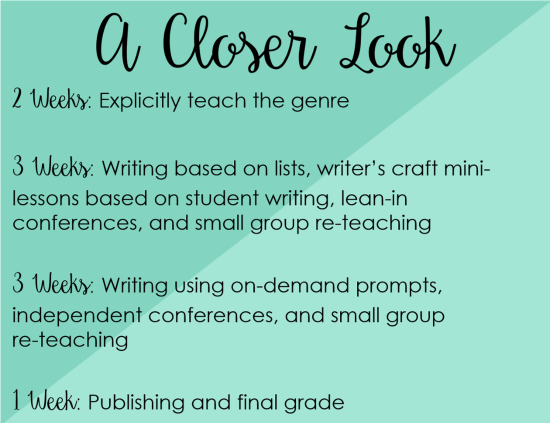
Note: I practice modify this a scrap for informational writing since I explicitly teach how-to writing, compare and contrast writing, and then explanatory/descriptive advisory writing split up and so together.
What Does a Typical Writing Lesson Look Like?
The total fourth dimension I accept for writing is 60 minutes (I volition share a modified schedule for 30 and 45 minutes, as well). Hither is how I typically segment my writing time. However, from reading the above section, yous will detect that sometimes mini-lessons or share times are shorter or longer, depending on where we are in our pacing.
- 15-20 infinitesimal mini lesson
- thirty-40 minutes for independent writing and conferences/small-scale groups
- five minutes for closing, sharing, and reflecting
Modified Schedule for 45 Minutes
- 15 minute mini-lesson
- 25 minutes for independent writing and conferences/small-scale groups
- five minutes for closing, sharing, and reflecting
Modified Schedule for 30 Minutes
For 30 minutes, I recommend more of an A/B type schedule. Something like this:
A Schedule: – xv mini-lesson and 15 minutes of independent writing where the students are direct applying the strategy to their writing
B Schedule: 20 minutes independent writing (connected from Monday) and conferences and 10 minutes for closing and sharing
Monday: A Schedule Tuesday: B Schedule Wednesday: A Schedule Th: B Schedule
Fri: Whichever schedule y'all demand to meet the needs of your students. I have found that information technology is better to cease the week with more contained writing to utilize all they take learned. Likewise, I prefer to begin the week with the mini-lesson.
Materials I Employ to Teach Writing
- Mentor texts- For mentor texts, I apply tradebooks (picture books and excerpts from longer works), released exemplars from state cess, pupil stories (shared with permission), and teacher-written stories. You can read how I used one mentor text during my persuasive writing unit by clicking hither.
- Anchor charts– As a class, we create anchor charts for most every writing mini-lesson I teach. Those anchor charts then provide an ballast for the students while they are writing. Want to see charts that I used to guide some my persuasive writing mini lessons? Click here to go direct to the post.
- Pupil reference charts – My students use their writing notebooks to keep their writing lists and to keep reference charts for most every lesson that I teach. We create an anchor nautical chart together and so I give the students a printable copy of the nautical chart that is already made or that I make after the fact. These charts are glued into their writing notebook and they refer to them regularly as they write.
- Sentence stems -Nigh of my students are nowhere about adept writers when they come to me. 1 way that I support my students is through sentence stems. Based on the needs of my students, I may provide sentence stems for beginnings, adding more details, using transitional phrases, or conclusions. The best part is that the stems give the students much needed confidence in their writing. As they become more confident, they will motion away from using the sentence stems and create more original and unique sentences.
What Almost Early Finishers?
Since I utilize a workshop model and the students work through the writing process primarily at their own pace, I exercise need to have expectations and procedures in place for early finishers. Hither are the iii unlike procedures I have put in identify over the years for my students who finish a writing slice early on:
i. The easiest ane is already embedded in my instruction: the students cull another writing topic from the list of topics nosotros generate at the showtime of a new genre.
2. The other option is to asking a peer conference with another student who is already finished. If you lot choose this, y'all demand to have a clear procedure in my identify for finding or requesting a student, what to practice if no one is set up to agree a peer conference with you, and you need to explicitly teach the students how to hold peer conferences.
three. For some students, they need a chip more than construction when it comes to choosing an "early on finisher" activity. This is where my writing choice boards come in. I take one option board per genre that I teach. As we learn about a genre, I impress the choice board and identify it on a ring. Over time, the ring will take several pick boards. Early finishers may grab a ring of boards (I make about 5-half dozen) and choose any prompt from any of the choice boards.
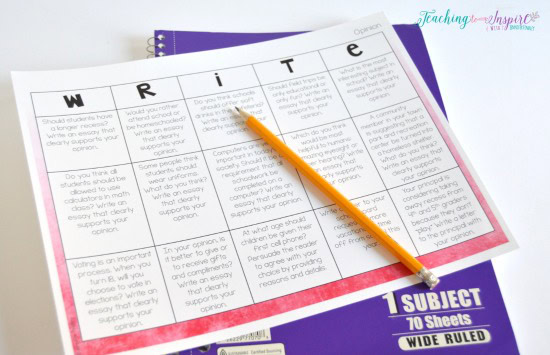
These writing choice boards are available in my TeachersPayTeachers store. The resource includes vii writing choice boards in all! Click here to see them now.
Preparing for Writing Assessments
The question I always become is: How do you use a workshop model and still ready your students for very "unworkshop" like writing assessments? The answer is that I embed it throughout in an authentic way. Allow'due south take a look at an instance:
My students are expected to write essays in response to 2 texts. And so, when my students are learning how to write compare and contrast essays, nosotros pull upwards information, manufactures, and read alouds for them to integrate their data from. This is authentically preparing them for the writing assessment in a way that even so engages them in the writing.
Here is some other instance:
While we are writing persuasive essays, we may read ii articles from two dissimilar perspectives on the topic we are writing. And then we will utilise those articles (and our own reasons and experiences) to craft a persuasive argument. Merely I never practice information technology in a this is "exam prep" way. I always try to authentically and naturally introduce the text as a way to support and strengthen our writing-this makes a HUGE divergence with the students' mindset.
Another fashion that I prepare my students is by taking the last ix weeks of my pacing (or 6 weeks if the writing test falls sooner) to review and practise all three genres of writing together. I call up information technology is very of import that the students are exposed to writing in all three genres together and not merely in isolation. This helps solidify the differences among the three types. A resource I use to bound-first my review of all three chief types of writing is my Writing Exam Prep Resources.

This resources has sorts, prompts, practice printables, teaching posters, and more than. It is a nifty style to review all three genres of writing and teach students how to clarify and respond to writing prompts. I use this resource at the beginning of my last nine weeks of instruction. Information technology lasts about a week to get through the resources and review all the genres.
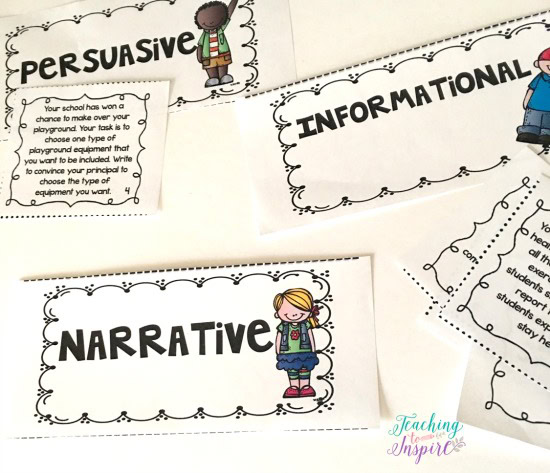
After using that resources, nosotros move into more rigorous text stimulus writing (as required by my state assessment). Still, because I accept embedded this blazon of writing in my instruction all yr, this is zero the students haven't already seen or done. The activities from the Writing Test Prep Resource then become into a test prep writing centers to continue reviewing before the day of the test.
I plan to write another blog post virtually preparing your students for writing assessments all year (and in authentic, engaging ways). Stay tuned for that!
Is how you teach writing similar or very different from how I teach? I would love to hear your thoughts on writing education. Let me know in the comments.
P.S. Do you desire to see how I teach reading? Click here to read a detailed postal service that breaks downwards how I teach reading in 5th grade.
Save
Save
Salve
Save
Salvage
Save
Salvage
Save
Relieve
Relieve
Save
Save
Salvage
Save
Relieve
Salve
Relieve
Save
Save
Salvage
Salvage
Salve
Salvage
Save
Save
Salvage
Salvage
Save
Relieve
Source: https://jenniferfindley.com/how-to-teach-writing-5th-grade/
0 Response to "Jennifer Findley 4th Grade Reading Pacing Guide"
Post a Comment